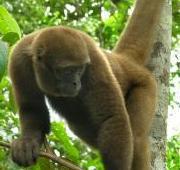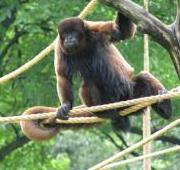 The woolly monkey is a medium to large sized primate, that inhabits the tropical forests of north-west South America. The woolly monkey is most well known for it's round-shaped head and dense fur that covers the body of the woolly monkey.
The woolly monkey is a medium to large sized primate, that inhabits the tropical forests of north-west South America. The woolly monkey is most well known for it's round-shaped head and dense fur that covers the body of the woolly monkey. Woolly monkeys are found throughout Colombia, Ecuador, Peru, Brazil and parts of Venezuela where they live an arboreal lifestyle. Woolly monkeys have long and very strong prehensile tails which allows them to balance and grip onto branches without having to give up the use of their hands.
Woolly monkeys are found throughout Colombia, Ecuador, Peru, Brazil and parts of Venezuela where they live an arboreal lifestyle. Woolly monkeys have long and very strong prehensile tails which allows them to balance and grip onto branches without having to give up the use of their hands.


Like many other primate species, woolly monkeys live together in fairly large groups known as troops. The woolly monkey troops contain both male woolly monkeys and female woolly monkeys. The woolly monkey troop is also known to split up into smaller groups when it is time to forage for food.
The woolly monkey is an omnivorous animal, meaning that it feeds on both plants and other animals. Fruit is the primary source of food for woolly monkeys, but they will also eat nuts, seeds, leaves, flowers, nectar, insects and even small rodents and reptiles.
Due to their relatively large size, woolly monkeys have few natural predators within their jungle environment. Large birds of prey such as eagles, are the main predators of the young woolly monkeys, and wildcats such as ocelot and jaguars are the main predators of the adult woolly monkeys. The human is also one of the main predators of the woolly monkey as they are hunted for their meat and fur.
The alpha male woolly monkey will mate with the females in his troop. After a gestation period of between 7 and 8 months, the baby woolly monkey is born. Woolly monkeys tend to only have one baby at a time although twins have been known to occur. The baby woolly monkey clings to it's mothers underside, before climbing up onto her back when it is around a week old. The baby woolly monkey is independent and no longer needs it's mother when it is around 6 months old.
Due to deforestation and therefore habitat loss, the woolly monkey population numbers are drastically decreasing, with the woolly monkey now considered to be an animal species that is vulnerable to extinction.

